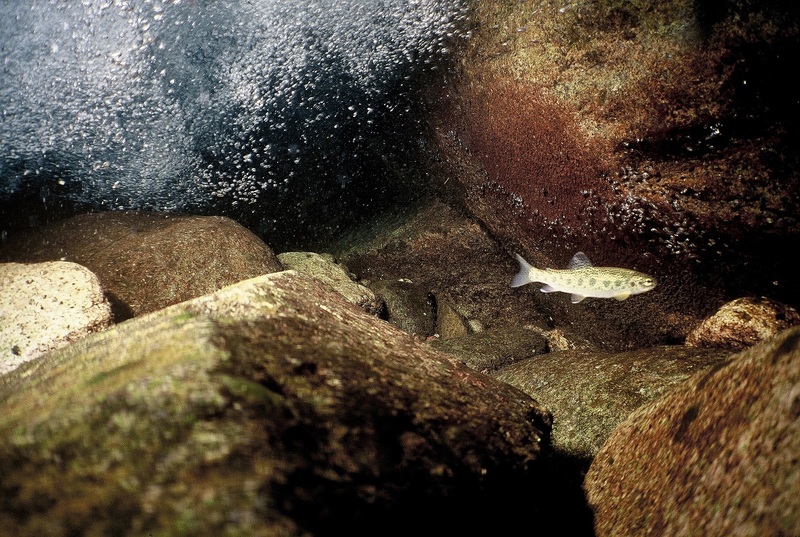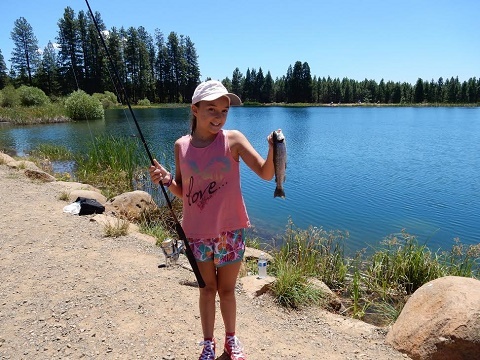Big Chico Creek Fish Report for 7-26-2016
A Hot Summer’s Day on Chico Creek
Big Chico Creek - Chico, CA

by Steven T. Callan
7-26-2016
Website
I’ve been exploring Northern California’s streams -- above and below the surface -- for most of my life. One of my most memorable adventures took place on a hot summer’s day in 1964, not long after my sixteenth birthday. My fishing buddy, Paul Martens, had heard that some trophy browns could be caught in upper Chico Creek. The only way into this treacherously steep canyon was an overgrown Caterpillar track that hadn’t been traveled or maintained in years. Throwing caution to the wind, I shoved my 1947 Chevy pickup into first gear, gingerly stepped on the gas, and inched down the steep embankment.
“I just bought a new Mitchell 300,” said Paul. “I can’t wait to try it out.”
“If this road gets any narrower you might not get your chance,” I replied.
Moving at a snail’s pace, it took us almost an hour to reach the end of the path.
“OK, where’s the trail?” I asked, climbing from the truck.
“It’s supposed to be here somewhere,” said Paul.
“It’s only nine o’clock and already hot,” I complained. “The temperature’s supposed to hit a hundred today.
Teased by the sound of the rushing water below, Paul and I peered over the canyon’s edge. All we saw was a seemingly impenetrable wall of scrub oak, manzanita, gray pine, and poison oak. Determined to reach the stream, we searched the canyon wall for a way down. Paul discovered what might have been some kind of human foot path a short distance from the truck. I thought it was nothing more than a deer trail, but it would have to do, so we gathered our gear and began the day’s adventure.
Both of us carried cloth fishing creels and two-piece spinning rods with reels attached. “Watch for snakes,” I cautioned, as we carefully squeezed between patches of poison oak. About fifty yards down, the trail disappeared and the canyon became even steeper. Sweat poured from our foreheads and into our eyes. The fear of stepping on a rattlesnake paled in comparison to the anticipated joy of reaching the stream and flopping into the refreshingly cool water.
Expletives rolled off our tongues as we crashed our way downward, pushing brush and sharp branches aside. “It’s too late to turn back, Paul. Keep going, we’re almost there!” I finally reached a clearing, a hundred feet above the stream. It was then that I heard Paul cry out, “Sheiiiit!” I looked up just in time to see my two-hundred-twenty-pound, bespectacled fishing buddy burst into view. He was still on his feet but sliding on the soles of his Converse All Stars, fishing rod and brand-new Mitchell reel firmly clutched in his right hand. Suddenly, his feet flew out from under him, and he fell backward onto the hard, red clay. The impact loosened Paul’s grip on the fishing rod and away it went, bouncing down the canyon, over the rimrock ledge, and into the stream below.
Paul’s rod and reel remained intact, but as luck would have it, they landed in what had to be the deepest pool in Chico Creek. Paul was devastated: We had run the gauntlet of steep terrain, poison oak, and rattlesnakes, only to have him lose his fishing gear. “We came all this way and now I can’t even fish!” said Paul.
“Cheer up,” I said, still laughing. “I’ll get your rod and reel back.” I reached into my creel and pulled out an old diving mask.
Paul and I carefully climbed down the remaining rocks to the water below. I marveled at the beauty of this Northern California trout stream. The water was crystal clear as it swirled between basalt boulders the size of automobiles, revealing one deep pool after another. Alders provided much-needed shade, creating an ideal environment for fish and other aquatic life.
Ditching my shoes, I carefully negotiated the rocky bottom until the water was shoulder deep. My face mask had not been used for some time, so I rinsed it, spit on the inside glass, and rubbed the saliva around before rinsing again and putting it on. Leaning forward, I stuck my head under water. The sounds from above were immediately silenced and replaced by the muffled noise of rushing water and millions of foaming bubbles flowing downstream. Pushing off from the stream bottom, I skimmed across the surface toward the steep cliff on the opposite side. Tucking my upper body and straightening my legs, I began my descent. Within seconds, I was ten feet below the surface, continuing downward. The water became dark and suddenly colder as pressure began to build in my ears. Several six-inch native rainbows darted by, disappearing into the waterfall upstream.
My peripheral vision was severely limited by the old face mask, but I managed a glimpse of something larger, much larger. I attempted to follow the giant trout, but with my lungs void of air, I gave in to the urge to surface.
Meanwhile, Paul was worried about his rod and reel. I gave up on finding the large fish and directed my attention toward Paul’s fishing gear, which was still lying on the stream bottom. Clearing my ears, I glided downward. Grasping the rod and reel, I noticed a rock overhang above my head. The light from the surface beamed down on the rock, creating a dark shadow. Suspended motionless in the shadow was the fish I had been looking for.
I slowly began my ascent, trying not to startle the fish. Reaching eye level, I saw that it was a large trout, but not one of the German browns Paul had heard about. It was two feet long, with flame red streaks on its gill covers and white tips on its fins. A faint pink stripe extended the length of the fish’s body. The brilliant colors became more evident as the magnificent trout slowly drifted out of the dark shadows and into the beams of light from above. Suddenly, with a thrust of its tail, the fish darted upstream and out of sight.
I reached the surface and handed Paul his fishing equipment. A smile came across his face. “I saw a steelhead,” I said, as I removed my face mask. “What a beautiful fish!” Remarkably, this holdover from the spawning season must have somehow made it past all of the natural and manmade barriers between the Sacramento River and upper Chico Creek.
Paul and I spent the rest of the day wading through the stream and casting silver and gold Mepps spinners. No big browns or steelhead were caught, but we hooked and released several native rainbows. It was almost dark when we finally stopped fishing and prepared for the arduous climb back to the pickup.
Before leaving, I took one more look around. I felt a sense of awe as I scanned the surroundings and listened to the water cascading over the rocks. Even as an inexperienced teenager, I recognized and appreciated the magnificent beauty of streams. They were nature’s life-giving jewels and I believed they should be preserved and protected at all cost.
That feeling would last the rest of my life.
This article was first posted in my August 2, 2014 column in MyOutdoorBuddy.com. It’s one of my favorites.
Steven T. Callan is the award-winning author of The Game Warden’s Son, named “Best Outdoor Book of 2016” by the Outdoor Writers Association of California and published by Coffeetown Press of Seattle. His debut book, Badges, Bears, and Eagles—The True-Life Adventures of a California Fish and Game Warden, was a 2013 “Book of the Year” award finalist (ForeWord Reviews).His upcoming book, Henry Glance and the Case of the Missing Game Warden, a novel, will be released in 2020. Steve is the recipient of the 2014, 2015, and 2016 “Best Outdoor Magazine Column” awards from the Outdoor Writers Association of California. He can be found online at steventcallan.com.
Next Report >
Next Report >
More Reports
A Perfect KIlarc Morning
Kilarc Reservoir
7-25-2016
Folks who read my stuff know how much I enjoy fishing with kids. They are, after all, the future...... Read More

7-17-2016
Knowing that it doesn't get much better than July for striped bass fishing on the beaches of San Francisco, I...... Read More

Website Hosting and Design provided by TECK.net